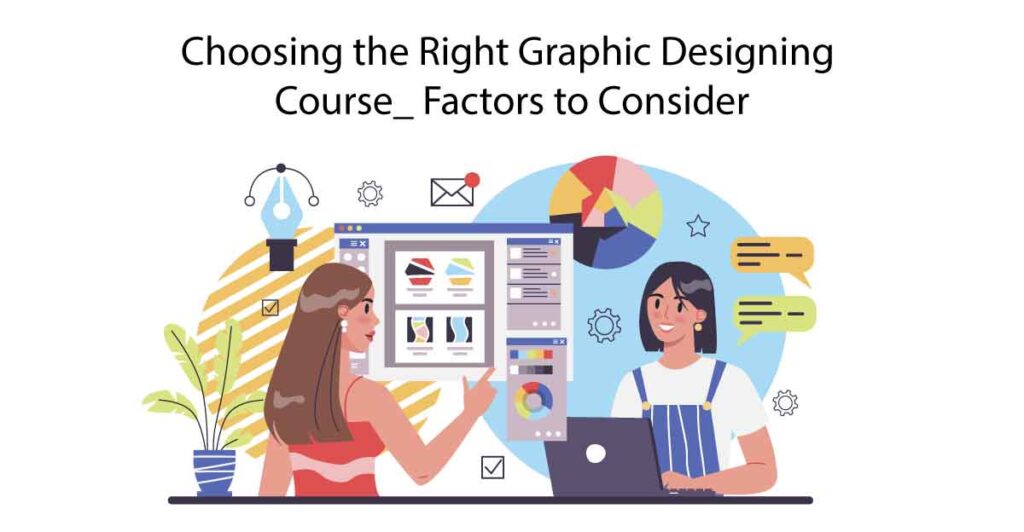
Are you considering delving into the world of graphic design? Whether you’re a beginner or seeking to enhance your existing skills, choosing the right graphic designing course in Jaipur is crucial. With an array of options available, selecting the best fit can be overwhelming. To ensure you make an informed decision, let’s explore the key factors you should consider when choosing a graphic design course.
Graphic Designing Course Factors
Key Considerations for Choosing the Right Path
Introduction to Graphic Designing Courses :
Choosing the best Graphic design course offers a pathway to acquiring essential skills in design software, layout techniques, and visual communication. Investing in the right course can significantly impact your career prospects and skill development.
Understanding Your Goals
Before embarking on your search, clarify your objectives. Are you aiming to kickstart a career in graphic design, or do you want to enhance your existing skill set? Understanding your goals will help narrow down your options effectively.
Career Aspirations
Identifying your long-term career aspirations within the graphic design field is essential. Whether your goal is to kickstart a career as a graphic designer, advance within your current position, or transition into a different role, defining your ambitions provides direction for selecting suitable courses.
If you aspire to become a freelance designer, you might prioritize courses that cover business skills, marketing strategies, and client management. For those aiming to work for a design agency, focusing on courses that emphasize teamwork, project management, and industry-specific software could be beneficial. Similarly, if you’re keen on specializing in a niche area such as web design, illustration, or branding, opting for courses tailored to those specializations can help hone your expertise.
By aligning your course selection with your career goals, you can tailor your learning experience to acquire the necessary knowledge and skills to thrive in your desired role.
Skill Enhancement
For individuals already immersed in the design industry, pursuing courses that offer advanced training in specific areas can be instrumental in skill enhancement and professional growth. These courses go beyond the basics and delve deeper into specialized topics, enabling you to stay updated with emerging trends and technologies within the field.
Consider areas where you feel you could benefit from additional expertise or where there’s a demand in the industry. Whether it’s mastering advanced techniques in digital illustration, learning motion graphics, or delving into UX/UI design principles, there are courses available to cater to various skill enhancement needs.
Furthermore, staying abreast of industry developments through continuous learning not only enhances your value as a designer but also opens up opportunities for career advancement and specialization.
Researching Available Courses:
The best institute for graphic designing in Jaipur, thorough research is essential. Explore both online and offline options to determine which mode of learning best suits your preferences and lifestyle.
Online vs. Offline Options
Evaluate the advantages and limitations of online and offline courses. While online courses offer flexibility and accessibility, offline courses may provide a more immersive learning experience with face-to-face interactions.
Curriculum Comparison
Compare the curriculum of various courses to ensure they cover essential topics such as typography, color theory, and layout design. Look for courses that offer a balanced blend of theory and practical application.
Accreditation and Recognition :
Opt for courses offered by accredited institutions or recognized training providers. Accredited courses adhere to quality standards, ensuring that you receive a valuable education that is recognized by employers in the industry.
Importance of Accredited Courses :
Accredited courses undergo rigorous evaluation to meet industry standards, assuring quality education and valuable certification upon completion.
Recognized Institutions
Research institutions with a reputable track record in providing graphic design education and producing successful graduates. Consider factors such as alumni achievements and industry partnerships.
Faculty and Expertise
The expertise of instructors plays a significant role in shaping your learning experience. Look for courses taught by qualified professionals with industry experience and a passion for teaching.
Qualified Instructors
Ensure that the course faculty possesses relevant qualifications and expertise in graphic design and related fields. Experienced instructors can offer valuable insights and mentorship throughout your learning journey.
Industry Experience
Instructors with hands-on experience in the design industry bring real-world knowledge and practical insights into the classroom, enriching your learning experience.
Course Duration and Flexibility :
Consider the duration and flexibility of the course schedule to ensure it aligns with your availability and commitments.
Full-time vs. Part-time Courses :
Evaluate whether a full-time or part-time course suits your lifestyle and learning preferences. Full-time courses may offer a more intensive learning experience, while part-time options allow for greater flexibility.
Flexible Schedules
Look for courses that offer flexible scheduling options, such as evening classes or weekend workshops, to accommodate your other responsibilities.
Curriculum and Specializations :
Examine the course curriculum to determine whether it covers a broad range of design principles and offers specialized modules in areas of interest.
Core Subjects Covered
Ensure that the curriculum includes core subjects such as Adobe Photoshop, Illustrator, and InDesign, along with fundamental design principles.
Specialized Modules Available
If you have specific areas of interest or career goals, seek courses that offer specialized modules or electives in those areas, such as web design, branding, or motion graphics.
Practical Training and Projects :

Hands-on experience is crucial for mastering graphic design skills. Look for courses that provide ample opportunities for practical training and portfolio development through real-world projects.
Hands-on Experience
Engage in practical exercises and design projects to apply theoretical knowledge and develop proficiency in design software and techniques.
Portfolio Development
To effectively present your abilities to prospective clients or companies, you must have a solid portfolio. Choose courses that offer guidance and support in building a professional design portfolio.
Facilities and Resources :
Access to state-of-the-art facilities and resources can enhance your learning experience and provide essential tools for creative exploration.
Access to Software and Tools
Ensure that the institute provides access to the latest design software and tools necessary for completing assignments and projects effectively.
Infrastructure of the Institute
Visit the institute or explore virtual tours to assess the quality of facilities such as design labs, studios, and library resources.
Alumni Success and Reviews :
Research the success stories of alumni from the course and read reviews and testimonials from past students to gauge the effectiveness and reputation of the program.
Alumni Network
An active alumni network can provide valuable networking opportunities, mentorship, and insights into industry trends and job prospects.
Testimonials and Reviews
Read reviews and testimonials from past students to gain insights into their learning experiences, job placements, and overall satisfaction with the course.
Cost and Financial A vid :
Evaluate the tuition fees and consider options
for scholarships or financial aid to make the course more affordable and accessible.
Tuition Fees
Compare the costs of different courses and consider the value proposition in terms of curriculum, faculty expertise, and career prospects.
Scholarships or Financial Aid Options
Explore scholarship opportunities, grants, or instalment plans offered by the institute to offset the cost of tuition and support your education.
Location and Accessibility :
Consider the location of the institute at your home or workplace and assess the accessibility of transportation facilities.
Proximity to Home or Work
Choose a course located conveniently to minimize commuting time and expenses, allowing you to focus more on your studies.
Transportation Facilities
Evaluate the availability of public transportation or parking facilities near the institute to ensure ease of access during your course.
Industry Connections and Internships :
Courses with industry connections and internship programs offer valuable opportunities for networking, gaining practical experience, and securing employment.
Tie-ups with Companies
Look for courses partnered with design agencies, studios, or companies that offer internships, job placements, or collaborative projects.
Internship Opportunities
Participating in internships allows you to apply classroom knowledge in real-world settings, gain industry experience, and build professional connections.
Career Support Services :
Choose courses that provide comprehensive career support services, including job placement assistance, resume-building workshops, and career counselling.
Job Placement Assistance
Access to job placement services can help you identify job opportunities, prepare for interviews, and connect with potential employers in the design industry.
Career Counselling
Seek guidance from career counsellors or advisors who can help you identify your strengths, goals, and career pathways within the field of graphic design.
Conclusion
Choosing the right graphic designing course requires careful consideration of various factors, including your career goals, learning preferences, and budget constraints. By conducting thorough research and evaluating your options based on accreditation, faculty expertise, curriculum, and industry connections, you can make an informed decision that sets you on the path to success in the dynamic field of graphic design.





